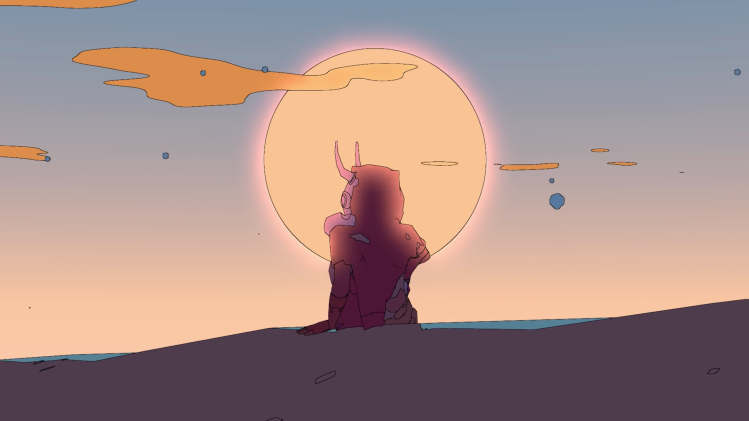The open-world exploration game Sable has an extraordinary art style, appearing as a kind of living science-fiction graphic novel. But the eponymous character’s journey is common in the world, a coming-of-age ritual that will urge her to cross massive sand dunes and explore palatial ruins. Developer Shedworks teamed up with publisher Raw Fury, and the game is due out sometime in 2019 for PC and consoles.
During last week’s Electronic Entertainment Expo, I was excited to dig into a hands-on demo. I was attracted to Sable’s sparse elegance and flat colors. And also, I saw that I would get to cruise around on a hoverbike.
Even though I was excited to take my new ride for a spin, Shedworks cofounders Gregorios Kythreotis and Daniel Fineberg noted that this is actually quite ordinary. Everyone in Sable’s world has a hoverbike. This is a thread that emerged several times in our conversation — even though this journey looks marvelous and alien, Sable isn’t special. Her quest for identity is a universal rite of passage in her culture, though everyone’s path is different.
“[The hoverbike is] also a really significant cultural element to this world,” said Kythreotis in an interview with GamesBeat. “It’s just how people survive on this planet. It’s a harsh environment. You need to travel long distances in extreme temperatures. This is your mode of transportation. So in the game, the hoverbikes are going to be customizable. Everyone’s hoverbike will be unique.”
June 5th: The AI Audit in NYC
Join us next week in NYC to engage with top executive leaders, delving into strategies for auditing AI models to ensure fairness, optimal performance, and ethical compliance across diverse organizations. Secure your attendance for this exclusive invite-only event.
The desert is the through-line in Sable. It’s the landscape you travel, but it’s also at the core of the culture you’re exploring. Shedworks did seek inspiration from desert societies on Earth, but it’s not drawing an analogy to any particular one. It instead looks at how people adapt to the environment, which informs how they behave.
“Things like, in the Sahara, all of the water holes are communal. They’re dotted all over the place. Although it’s very big and there’s not very many people in the Sahara, at any given moment you know where a lot of other people are, because they gather around the water holes,” said Fineberg. “It affects the etiquette you show when you meet strangers. They’re a lot less hostile toward each other, because if you don’t share your resources, if you’re not at least willing to share your resources, you’ll die.”
And it informs the architecture as well.
“I’m half Cypriot. In Cyprus, you might paint your buildings a particular color to repel the heat. The heat gets extreme there, and you might paint it a certain color, or in smaller villages you get really narrow alleys and streets and stuff, to create shadows,” said Kythreotis. “Those shadows allow people to move between each other’s houses without being exposed to heat. That’s something we want to inform the world. Being cognizant of those things is important. It goes beyond just the behavioral qualities of the culture, but also down to just the architecture qualities as well.”
Much of Sable’s alien culture emerged from necessity, which also ties in nicely with how Shedworks decided on the desert setting in the first place. As a two-person team, they had to be mindful of how many resources they had at their disposal.
“When we first had the idea for the desert, the reason why it was a good for us because there’s not that much in the desert. It’s very big, and you get the sense of scale, but it’s empty. It’s OK if there’s not loads of buildings,” said Fineberg. “It was a practical implication, but from there, then you get this really amazing sense of loneliness and openness. Looking at the horizon and being completely on your own. Then suddenly that informs the music and the visuals.”
Another key element in the world’s culture is the idea of masks. Players can choose which mask Sable wears, and this changes the way people communicate with her. It’s a way to differentiate herself but it’s also something that is instantly recognizable to others on her journey.
“People you meet in the world, they know what you’re doing,” said Fineberg. “‘Ah, I remember when I was your age and I came round to this village.’ Or, ‘When I went on mine, I went to your village, I know where you’re from.’ And so there’s a kind of familiarity about the world. You’re learning about it, learning from the people who have come before you, learning about your place in it, you and Sable.”
It makes sense that Shedworks has recruited Meg Jayanth, the lead writer for Inkle’s award-winning travel-based narrative adventure 80 Days. Kythreotis says that that game was a “really strong reference” for what they wanted to do with Sable.
“We want the player to choose what mask they wear. Depending on what they’re wearing, it changes how they present themselves to other people in the world. There are multitudes of ways that we hope that affects the narrative,” said Kythreotis. “The desert almost acts like a connective tissue that links together the short stories we want to tell throughout the world.”
It’s up to you how you want to interact with Sable — whether that’s solving puzzles in the ruins, visiting every camp and talking to fellow travelers, or collecting different modifications for your hoverbike. But no matter what you do, the desert will always be there, and it will always be a backdrop to all your decisions and a crucial part of your story.


